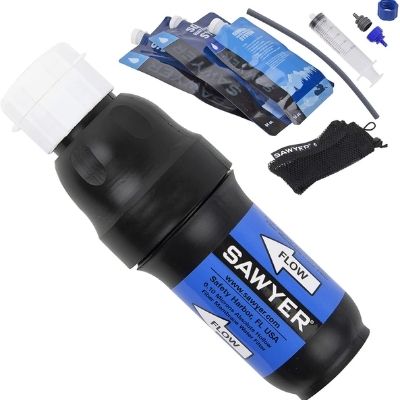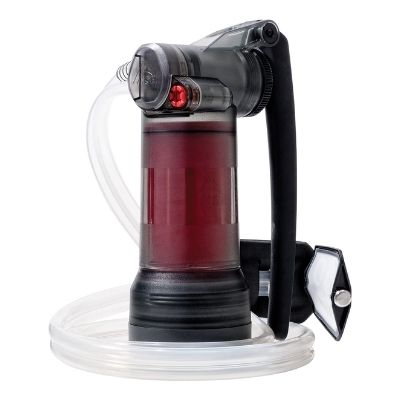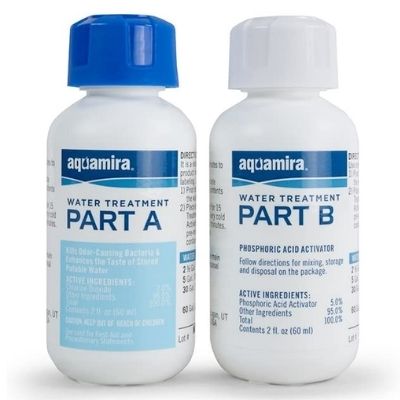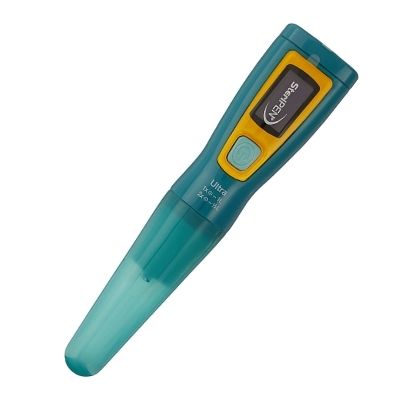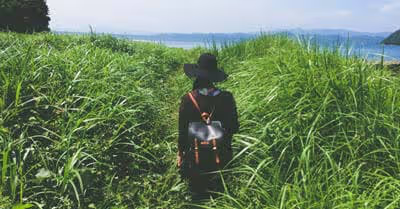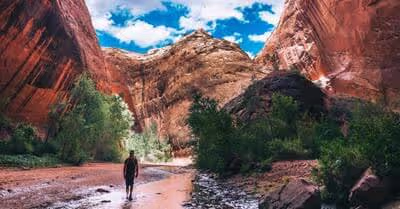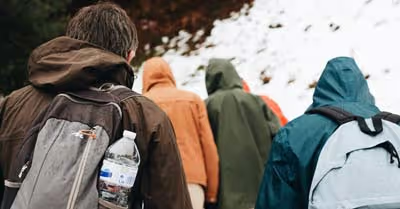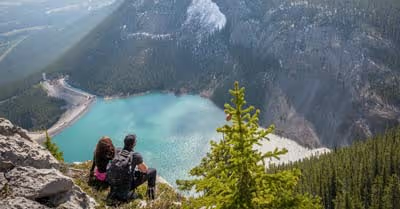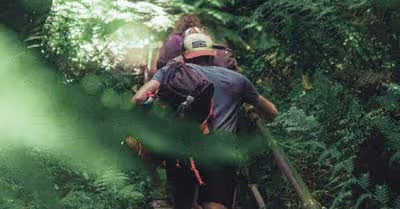Table of Contents
The 5 best hiking water filters
Because there are so many options on the market, finding the right one for you might seem a little overwhelming. luckily, you can use this next section to help you find a hiking water filter that might suit your needs. Here are 5 of the best ones for you to choose from:
Sawyer Squeeze
Picture of the Sawyer Squeeze Bottle
The sawyer squeeze is one of the best choices for everyday use. It uses a combination of squeeze and gravity to force the water through its filter. It is ideal for drinking directly from the bottle, but can also be used to pump water into a clean container. It has a very thin filter that can filter out 99% of the most common bacteria and pathogens. The filter itself is small, light, and easy to use. This is why it so popular with hikers.
How much it can purify in its lifetime: 100,000 liters
How much it costs on average: $66.51
Dollar per liter ratio: $1 = 2,222 liters
HydroBlu Versa Flow
Picture of the HydroBlu Versa Flow
This filter is great for everyday use too. It fits perfectly on top of a standard plastic bottle, meaning you can pump directly into your bottle with ease. Just like the Sawyer squeeze, it can be used as a gravity filter or squeeze filter. It comes with two squeeze bags with intake and outtake valves, color-coded, to ensure there is no contamination. This filter is just as long-lasting as the sawyers squeeze, which one you choose is entirely preference-based.
How much it can purify in its lifetime: 100,000 liters
How much it costs on average: $22.95
Dollar per liter ratio: $1 = 4,166 liters
Purchase the HydroBlue Versa Flow
MSR Guardian
Picture of the MSR Guardian
The MSR Guardian is perfect for large groups. It may cost more and produce less over its lifetime, but it can produce more clean water far quicker in the short term. The MSR Guardian is capable of filtering 2.5 liters of water an hour. The above filters can’t even touch that production. This filter is ideal for filling and leaving overnight, so the group has clean water in the morning. This filter is self-cleaning and requires very little maintenance. It does way almost 20 pounds but will provide water for the entire group. Whether or not this is the right size for you is based almost entirely on the size of the group you are hiking with.
How much it can purify in its lifetime: 10,000
How much it costs on average: $389.95
Dollar per liter ratio: $1 = 28.5 liters
Aquamarine Purification Drops
Picture of Aquamarine Purification Drops
These chlorine dioxide water purification tablets are great for keeping in your backpack, just in case, you might need them. They are one-time use tablets that are great if you are in a pinch but should not be relied on in the long term. Chlorine tablets can make you sick if you keep using them every time you drink. If its a choice between chlorine water or no water, choose chlorine, otherwise its best to use a gravity water filter.
How much it can purify in its lifetime: 120 liters
How much it costs on average: $18
Dollar per liter ratio: $1 = 6.5 liters
Purchase Aquamarine Purification Drops
Steripen Ultra
Picture of the Steripen Ultra Water Purifier
This handy little tool is great for cleaning water on the go. It uses powerful UV rays to neutralize bacteria and pathogens in the water. You simply turn it on, stir the water with it for about 2 minutes and watch as it cleans the water. This tool is great for keeping in your backpack for emergencies. It is a good idea to use a mix of this and chlorine tablets. It is USB rechargeable meaning it can be recharged with a battery pack for your phone or a hand crank USB charger.
How much it can purify in its lifetime: 8000 liters
How much it costs on average: $80.84
Dollar per liter ratio: $1 = 100 liters
How much water do I need to bring on a hike?
How much water you need to bring on a hike depends on several factors. How big you are, where you are hiking, when you are hiking, how far you are hiking, and whether or not there will be water sources on the way.
For example, someone who is choosing to hike a full day through the deserts of Arizona will want to bring at least a gallon of water with them. Conversely, someone who is doing a three-hour hike through the rocky mountains of Utah will only need two 18 ounce bottles. Someone much bigger, like a 6-foot tall man, will need more. Someone smaller, like a 4-foot tall child, will need far less.
It is always important to try and bring at least a gallon of water for a full day hike. You may not need it all, but you will be glad to have it. It is always better to have too much water than too little. Especially in the desert.
Then you have to consider whether or not you will be able to replenish your water supplies. If you are hiking through the woods and over the streams of Oregon it will be easy enough to top up your water supply. If you are hiking through the mountain passes of Sedona Arizona you are going to find water sources few and far between. Even if you are expecting to be able to fill up your water bottle regularly it is still advised to bring enough water in case some of the streams should run dry. You would hate to get caught out. It is also a good idea to bring a water filter with you.
How much water do I need to drink per hour?
Everyone needs to consume different amounts of water based on their size and how hard they are having to work. The healthier you are, the less water you are likely going to need. This is because you will be losing less water through perspiration. A good rule of thumb for everyone is to drink between one and two cups of water an hour. This is recommended for your everyday life, not just hiking. This is equal to about 16 ounces. A good amount for hiking is about 1.5x of this amount. So for a 4-hour hike, 75-95 ounces of water is perfect.
There are some ways to decrease the amount of water that you need to drink. One of these ways is by supplementing your intake with sports drinks like Gatorade. These sports drinks replenish your electrolytes faster than water and can help keep you from becoming too dehydrated. It is important to only drink one or two sports drinks because of all the sugar. In excess, sugar is interestingly more dehydrating negating the benefit of the drink in the first place. Another way is by taking a salt tablet. This salt tablet raises your body’s sodium levels and helps you keep your water in your body. It makes you need to relieve yourself far less frequently. It also makes you sweat less. This can backfire in the desert, where you want to be sweating to keep you cool.
Do I need a hiking water filter?
Whether or not you one hundred percent should bring a hiking filter depends on your needs. If you are going hiking for just a few hours, no, bringing a hiking water filter is not necessary. Sure, there are still some advantages of having one but it isn’t something you are going to struggle without.
Furthermore, you aren’t going need a hiking water filter if you are walking somewhere that doesn’t have any water to filter in the first place. It’s probably not worth bringing in the desert, but of course, you never know. There is no harm in being cautious.
The main reason you might want to bring a filter is if it simply isn’t feasible to bring the necessary amount. If you are planning on going on a 3-day hike, you may not be able to carry 3 gallons of water. This is the same as carrying 25 pounds of added weight the entire time. Not to mention just how much space that much water would take up in your pack.
When you are hiking such a long distance you only have one option. To refill your water containers. This can be done by boiling off snow, which is of course only an option if you are hiking through somewhere that has snow, or by filtering running water. To do this, you will need a high-quality water filter.
Why can’t I just drink the stream water?
You might be wondering why you need a water filter and cant just fill your container up from the river or stream directly. The answer is, you can. That’s how people have collected water for thousands of years. The need for a water filter is not always as much of a total necessity as it is just a personal preference. Most of the time the water is crystal clear, perfectly clean, and perfect for drinking straight from the source. But, this is not always the case. Sometimes, the water is dirty and full of bacteria or small particles of sand and dust. This isn’t going to kill you, but it can be unpleasant to drink potentially even making you ill.
Using a water filter will remove all of these impurities before you ingest them. It takes very little time and can save you a lot of head, or stomach, ache down the trail. A water filter is not going to make it possible for you to drink dirty groundwater, it is just to make drinking freshwater better. There are some simple ways of checking whether water will be fine to drink through a filter or whether it would need boiling off/iodine tablets first. The first way of checking is by assessing whether or not the water is running. If you find a stream of water that is running quickly, this means it is generally okay to drink from. If the stream is barely moving and is essentially stationary, it is best to give it a miss. Stagnant water is a breeding ground for bacteria and insect larvae. Running water is always best.
If you do find yourself having to drink from a pond or a lake, it is a good idea to check the surrounding area for dead animals or signs of pollution. If you don’t find any, then the water may be safe to drink. There is still no guarantee though. In this situation it is a good idea to boil the water, then filter it. If you have the correct equipment with you, of course. If you have a clear plastic bottle, fill it up with water from the source and then leave it to rest for a few minutes. After 10 minutes you will see any particle matter fall to the bottom of the bottle. If you don’t, great the water is fine to drink through your filter. If you do begin to see a thin layer of dirt at the bottom of the bottle be grateful you didn’t drink the water yet.
How do I use a hiking water filter?
There are a few different types of filters, so it depends on which type you use. There are three types of filters you will typically choose from. They are either gravity filters, squeeze filters, or purification tablets. They each have their uses and can vary in price.
Some filters work better than others depending on how many people are in the group and what source of water you are using. If you, for example, are hiking alone a squeeze filter would work very well. Squeeze filters rely on you forcing the water through filters as you drink.
If you are in a big group, squeeze filters are unhygienic and inconvenient. In this scenario, a gravity filter would work best. This just means the water’s weight will cause it to slowly work its way through the filter. This is similar to how your water filter at home if you have one, would work.
Lastly, there are purification tablets. They work by releasing a type of chlorine into the water that kills all pathogens. This works great as a temporary solution, over time it can make you quite sick. Iodine tablets can make drinking seemingly dirty water possible if combined with a filter. This isn’t recommended, though.
Conclusion
Hopefully, you now have a good idea about how and why water filters can be so useful. They are pretty simple to use, easy to carry, and can save your life. If you are looking for a few things to keep in your medical kit some chlorine tablets and a Sawyer Squeeze are easy to carry and easy to use. It is better to have these filters and not need them than find yourself stuck with no drinkable water.
Recent Articles



